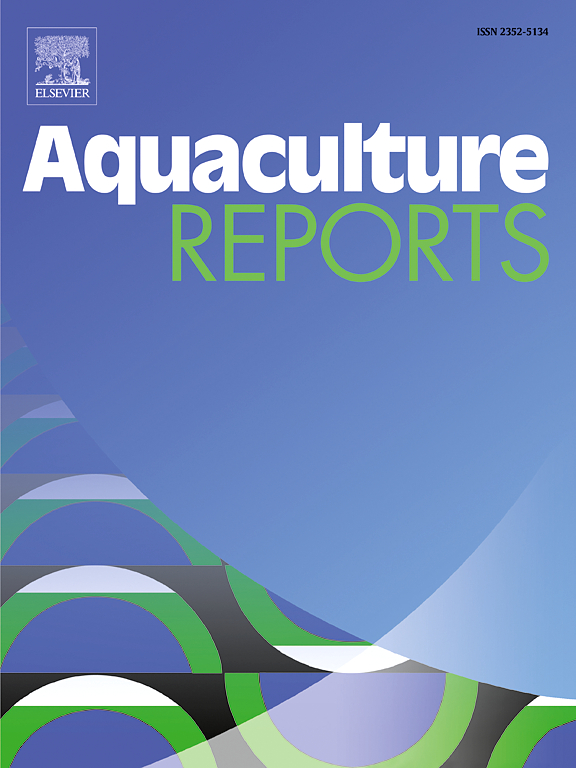Using invasive weed (Bidens pilosa L.) as a feed supplement to promote Nile tilapia (Oreochromis niloticus) health
IF 3.2
2区 农林科学
Q1 FISHERIES
引用次数: 0
Abstract
Bidens pilosa is a widespread invasive species typically regarded as a weed with no economic value. Repurposing this plant as a functional feed ingredient presents a sustainable, cost-effective approach for aquaculture. This study evaluated the effects of adding dietary B. pilosa leaf ethanol extract on growth performance, immune responses, gene expression, and disease resistance in Nile tilapia. Experimental diets supplemented a basal feed with B. pilosa extract at 2.5 g/kg (T2), 5.0 g/kg (T3), and 10.0 g/kg (T4); the control group (T1) received no supplementation. After a 60-day feeding trial, fish in the T2 exhibited significantly higher weight gain, daily growth rate, and an improved feed conversion ratio (FCR) compared with the control group (P < 0.05). Additionally, the T2 group had the highest fillet yield and the lowest carcass yield (P < 0.05). Biochemical analyses revealed that the highest extract level (T4) induced oxidative stress and immune dysregulation, including both immune suppression and potential ineffective immunity, evidenced by elevated aspartate aminotransferase (AST) and malondialdehyde (MDA) levels, alongside decreased lysozyme activity (LZM), myeloperoxidase (MPO), red blood cell (RBC) count, and hemoglobin (Hb) concentration (P < 0.05). In contrast, the T2 group exhibited the highest post-challenge survival (53.33 ± 15.27 %) against Streptococcus agalactiae and upregulated growth hormone (GH) and glutathione peroxidase (GPx) gene expression (P < 0.05). Quadratic regression analysis estimated the optimal inclusion level at 4.29–4.58 g/kg. These findings demonstrate that supplementation at 2.5 g/kg enhances growth, immune competence, and disease resistance in Nile tilapia, whereas excessive inclusion (10 g/kg) may provoke oxidative stress, dual immune suppression, and inflammatory toxicity, underscoring the importance of precise dosage optimization for sustainable aquaculture.
利用入侵杂草(Bidens pilosa L.)作为饲料补充促进尼罗罗非鱼(Oreochromis niloticus)的健康
毛毛拜登是一种分布广泛的入侵物种,通常被认为是一种没有经济价值的杂草。重新利用这种植物作为功能性饲料成分为水产养殖提供了一种可持续的、具有成本效益的方法。本研究评估了在饲料中添加刺槐叶乙醇提取物对尼罗罗非鱼生长性能、免疫反应、基因表达和抗病能力的影响。试验饲粮在基础饲料中分别添加2.5 g/kg (T2)、5.0 g/kg (T3)和10.0 g/kg (T4)的毛茛提取物;对照组(T1)不补充。经过60 d的饲养试验,T2组鱼的增重、日生长率和饲料系数均显著高于对照组(P <; 0.05)。T2组鱼片产量最高,胴体产量最低(P <; 0.05)。生化分析显示,最高水平的T4诱导氧化应激和免疫失调,包括免疫抑制和潜在的无效免疫,其证据是天冬氨酸转氨酶(AST)和丙二醛(MDA)水平升高,溶菌酶活性(LZM)、髓过氧化物酶(MPO)、红细胞(RBC)计数和血红蛋白(Hb)浓度降低(P <; 0.05)。T2组对无乳链球菌的攻毒后存活率最高(53.33 ± 15.27 %),生长激素(GH)和谷胱甘肽过氧化物酶(GPx)基因表达上调(P <; 0.05)。二次回归分析结果表明,最佳包埋水平为4.29 ~ 4.58 g/kg。这些研究结果表明,2.5 g/kg的添加量可以促进尼罗罗非鱼的生长、免疫能力和抗病性,而过多的添加量(10 g/kg)可能会引起氧化应激、双重免疫抑制和炎症毒性,强调了精确优化剂量对可持续水产养殖的重要性。
本文章由计算机程序翻译,如有差异,请以英文原文为准。
求助全文
约1分钟内获得全文
求助全文
来源期刊

Aquaculture Reports
Agricultural and Biological Sciences-Animal Science and Zoology
CiteScore
5.90
自引率
8.10%
发文量
469
审稿时长
77 days
期刊介绍:
Aquaculture Reports will publish original research papers and reviews documenting outstanding science with a regional context and focus, answering the need for high quality information on novel species, systems and regions in emerging areas of aquaculture research and development, such as integrated multi-trophic aquaculture, urban aquaculture, ornamental, unfed aquaculture, offshore aquaculture and others. Papers having industry research as priority and encompassing product development research or current industry practice are encouraged.
 求助内容:
求助内容: 应助结果提醒方式:
应助结果提醒方式:


